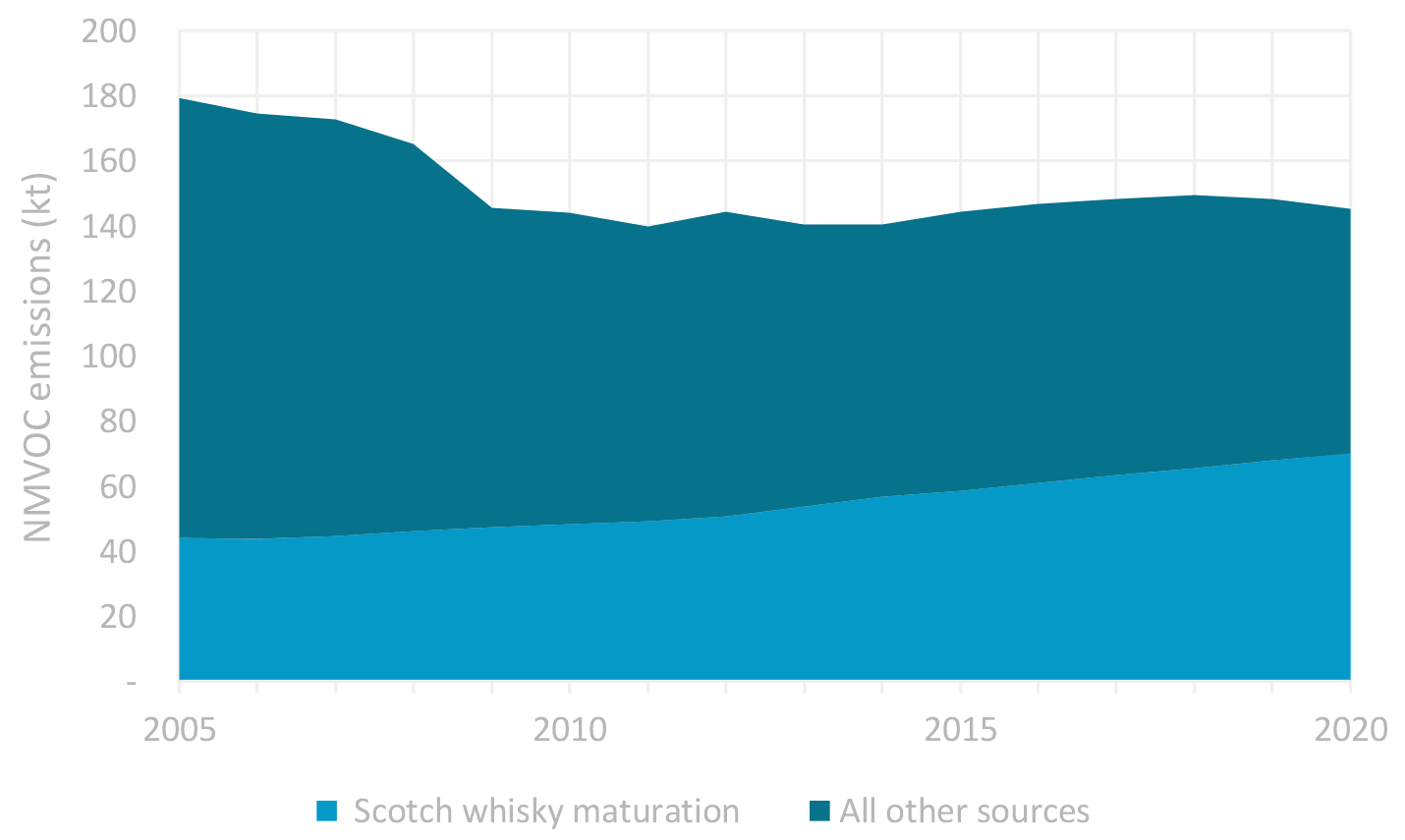Non-methane volatile organic compound emissions from malt whisky maturation: final report
Review of the human health and environmental impacts of non-methane volatile organic compound emissions from malt whisky maturation facilities prepared for the Scottish Government by Aether.
1 Introduction
The Scotch whisky industry is of significant worth to Scotland, both culturally and economically. In 2022, Scotch whisky was responsible for 77% of Scotland’s food and drink exports and employs over 11,000 people directly (Scotch Whisky Association, 2023). The industry has grown significantly in recent years, and this is predicted to continue. In 2022, a total of 22 million casks lie in Scotch whisky maturation warehouses in Scotland (Scotch Whisky Association, 2023a). Exports of Scotch whisky to meet the demand of the global market were worth £6.2 billion in 2022 (Scotch Whisky Association, 2023a). This is an increase of £3.8 billion since 2003, requiring increased production of Scotch whisky to meet the demand (SWA, 2023b).
During different parts of the process of whisky production non-methane volatile organic compounds (NMVOCs) are produced and released into the atmosphere, most significantly from malt whisky maturation as the product is stored and aged in oak casks (a key part of whisky making). NMVOC emissions from malt whisky maturation increased by 60% between 2005 and 2020, reflecting the expansion of the industry over this period. Figure 1 represents the proportion of all Scotland’s NMVOC emissions from Scotch whisky maturation in the fifteen years to 2020 and reflects the increase in Scotch whisky production over this time. Total NMVOC emissions from Scotch whisky maturation were over 70,000 tonnes in 2020 (Garland et al., 2022), a figure that represents around half of all NMVOC emissions from anthropogenic sources in Scotland.

Although there is good evidence on the general human health and environmental impacts of NMVOCs, relatively little is known about the impacts of this specific source and whether the recent increases in emissions from malt whisky maturation are sufficient to generate any significant health or environmental impacts.
Aether was commissioned by the Scottish Government to review the potential human health and environmental impacts of NMVOC emissions from malt whisky maturation, as well as to understand the geographic distribution of the multiple small point sources that make up this sector in Scotland.
Additionally, this review assesses NMVOC emissions from Scotch whisky maturation in the context of NMVOC emissions from other sources, and the potential for mitigation measures to control these emissions.
Key whisky industry and regulatory bodies within Scotland were engaged with in order to provide them with the context of this project and to gain their insights.
The Scotch Whisky Association (SWA) and Scotch Whisky Research Institute (SWRI) were aware of the study and were able to provide us with relevant information on whisky maturation which has been included within this report. These bodies would be an important route if further engagement with the whisky industry on any potential regulatory and policy development is required.
The Scottish Environment Protection Agency (SEPA) advised on links between this study and the Cleaner Air for Scotland 2: Towards a Better Place for Everyone Strategy. They provided their Scotch Whisky Sector Plan which outlines how they work with and regulate the whisky industry.
1.1 Report Structure
This report seeks to understand the likely human health and environmental impacts related to the NMVOC emissions associated with Scotch whisky maturation, and any mitigation measures which may be available. Section 2 provides details on the general properties of NMVOCs which may impact the effects the emissions may have on human health and the environment. The pollutant category NMVOC includes many different compounds. Therefore, Section 2.2 also contains information on the specific NMVOC emissions from Scotch whisky and their properties.
In Section 3 we consider the geographical distribution of Scotch whisky facilities and their associated NMVOC emissions. This includes a discussion of the data included within industrial emissions reporting streams and the data included in the National Atmospheric Emissions Inventory (NAEI). Sections 4 and 5 explore the pollutant pathways and their associated human health and environmental impacts. An assessment of the significance of the risk for each pathway is made.
Following the exploration of potential impacts, the potential for NMOVC emissions mitigation from Scotch whisky facilities is discussed in Section 6. Conclusions and any recommendations based upon the research outlined in previous sections are included in Section 7.
Contact
Email: airquality@gov.scot
There is a problem
Thanks for your feedback